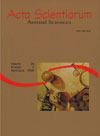<b>Effects of feed restriction on reproductive performance of breeder broilers</b> - DOI: 10.4025/actascianimsci.v28i2.643
Abstract
Feeding restriction is used for breeder broilers in order to limit the gain of corporal weight and to optimize their reproductive performance. It is necessary to moderate the rate of precocious growth through programs of feed restriction. This work aimed to evaluate the effects of feed restriction on the reproductive performance in breeder broilers males. The following treatments were evaluated: T1 = control; T2 = 6 days feeding and 1 day without feeding; T3 = 5 days of feeding and 2 day without feeding. 18 animals of the lineage Avian Farm were used. The parameters evaluated were: corporal weight, testicular weight, seminal characteristics of 6 animals per treatment at the age of 219 days. Randomized complete blocks were used to test the treatments effects. Significant differences were not observed (p > 0.05) among the treatments for corporal weight, testicular weight, mean weight gain, spermatic motility and vigor and total cells number. Spermatic concentrations were lower (p < 0.10) in the animals that received the treatments T1 and T3. The animals of T2 showed higher ( p < 0.05) seminal volume. The program of 6 days feeding and 1 day without feeding can be used in breeder broilers males of the lineage Avian Farm without affecting reproductive performance.Downloads
Download data is not yet available.
Published
2008-02-15
How to Cite
Alvarenga, A. L. N., Murgas, L. D. S., Souza, S. Z. de, & Gustin, P. C. (2008). <b>Effects of feed restriction on reproductive performance of breeder broilers</b> - DOI: 10.4025/actascianimsci.v28i2.643. Acta Scientiarum. Animal Sciences, 28(2), 159-163. https://doi.org/10.4025/actascianimsci.v28i2.643
Issue
Section
Animal Breeding and Reproduction
DECLARATION OF ORIGINALITY AND COPYRIGHTS
- I Declare that current article is original and has not been submitted for publication, in part or in whole, to any other national or international journal.
The copyrights belong exclusively to the authors. Published content is licensed under Creative Commons Attribution 4.0 (CC BY 4.0) guidelines, which allows sharing (copy and distribution of the material in any medium or format) and adaptation (remix, transform, and build upon the material) for any purpose, even commercially, under the terms of attribution.
Read this link for further information on how to use CC BY 4.0 properly.
0.9
2019CiteScore
29th percentile
Powered by 








































